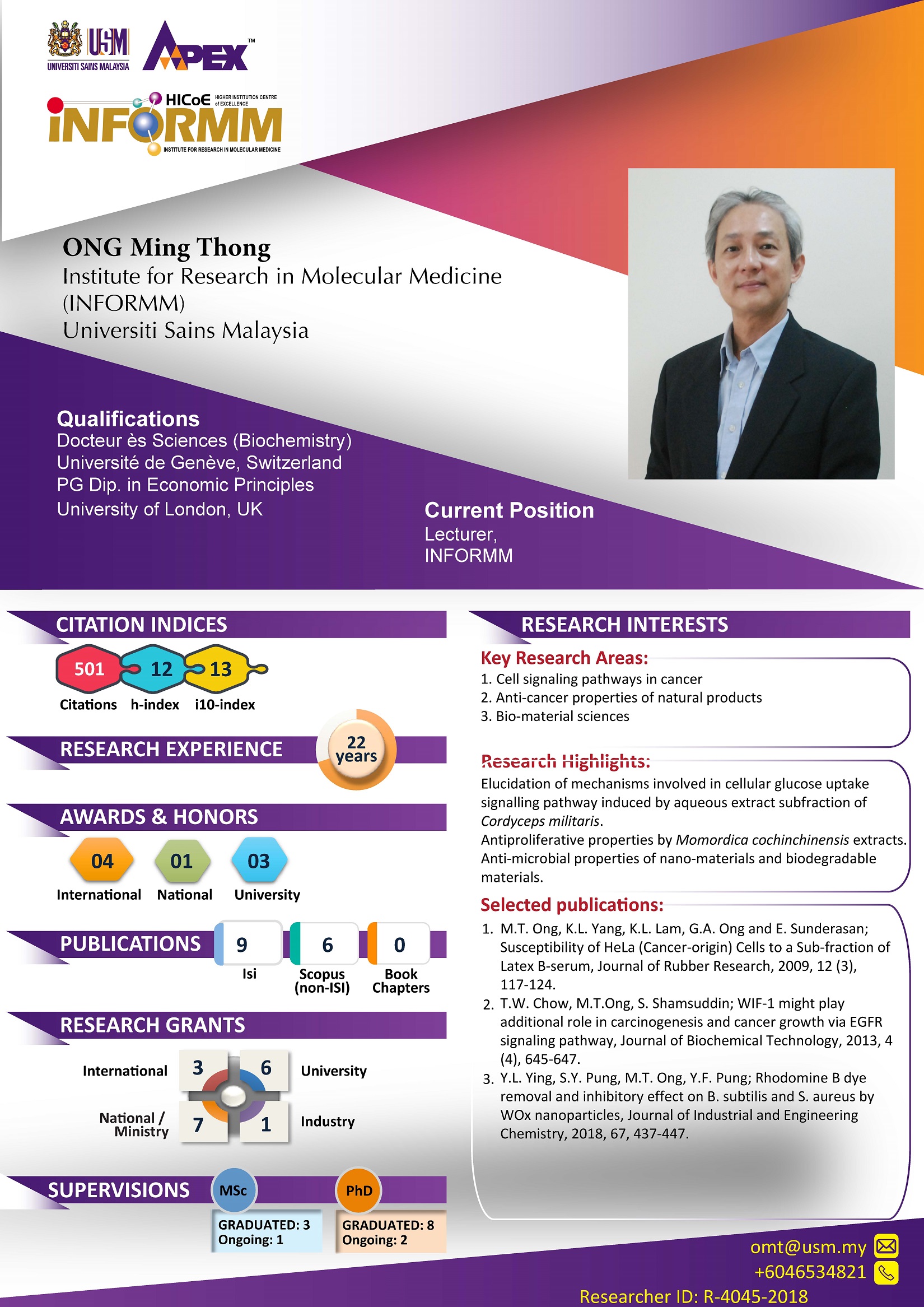Ong Ming Thong


Name
ONG Ming Thong
Current Position
Senior Lecturer
omt@usm.my
Office Telephone
+604-6534821
Personal Lab Website
http://omtgroupers.weebly.com/
Qualifications
BSc, Université de Genève, 1994
MSc, Université de Genève, 1995
P.G. Diploma (Econs), University of London, 1997
DSc, Université de Genève, 2000
Affiliations
Malaysian Society for Microbiology
Malaysian Society of Neurosciences
Research Interests
cancer, cell signaling, natural product, diagnostic, cell-based assay
Research Overview 1
Anti-proliferation properties of H. brasiliensis latex sera
Latex from the natural rubber tree known as Hevea brasiliensis has always been considered as an economic commodity and never been thought as a medicinal alternative until recently. Our findings have indicated that latex B- and C- sera possessed anti-proliferation properties against specific human cancer-origin cell lines. The study has confirmed that latex C-serum fractions, DCS and DCP, were able to exert its anti-proliferation properties against cancer-origin cell lines and the cell death mechanism has been identified. DCS- and DCP-treated HepG2, MCF-7 and MDA-MB231 cells were positively-stained with propidium iodide and negatively-stained with Annexin V, indicating apoptosis might not be the mechanism of cell death. Cell cycle analysis using BrdU incorporation showed that the treated cells were arrested in G0/G1 phase compared to the non-treated cells. Furthermore, ultrastructural changes of DCS- and DCP-treated cells observed using SEM and TEM confirmed the cell death mechanism triggered as autoschizis. In addition to its potential medical use in cancer treatment, DCS fraction could be used to study the molecular signaling pathway(s) involved in autoschizis. Work is being conducted in animal model to explore the potential of the fractions in cancer treatment.
Research Overview 2
Study on the involvement of WIF1 in initiating oral carcinogenesis via EGFR signaling pathway
The capability of WIF-1 to act as a ligand to EGFR and trigger carcinogenesis or metastasis might explain the observations wherein the expression of WIF-1 was high in cancer cases (Suzuki et al. 2007a; Suzuki et al. 2007b). In these cases, WIF-1 might be playing dual roles by inhibiting WNT signaling pathway on one hand, but initiate EGFR signaling pathway on the other hand. This latter would engrave the situation by promoting cancer cell growth, while researchers are expecting WIF-1 being playing a cancer-cell-growth inhibiting role. The confirmation of the “bad guy” role of WIF-1 under the camouflage of it as inhibitor of WNT signaling pathway would pave new insights to the cancer formation and eventually assist in cancer treatment research. Current activities are focused on the activation of beta-catenin and the downstream activities following the activation of beta-catenin via phosphorylation, including identification of control element of downstream gene expression.
Research Overview 3
Study on antiproliferation mechanisms exerted by Nepenthes rafflesiana pitcher pot fluid
Nepenthes rafflesiana is well known pitcher plant in Penang, Malaysia. The pitcher pot fluid was collected and fractionised according to the molecular sizes of the compounds in the fluid. Our group have found that subfraction G1 of the fluid would inhibit the proliferation activity in (breast) cancer-origin MDA-MB231 cell line but not in non-cancer-origin MCF-10A cell line. The mechanism has been found to be initiated by the G1 subfraction via EGFR-associated estrogen receptor (ER) alpha-36 subunit. The pathway taken by this would lead to the down-regulation of p38 MAPK. Current work is being conducted on the elucidation of downstream cell signaling pathway(s) involved in this molecular event after p38 being affected.
Selected Publications
1. Ong MT, Yang KL, Lam KL, Ong GA, Sunderasan E. Susceptibility of HeLa (Cancer-origin) cells to a Sub-fraction of latex B-serum. J. Rubb. Res. 2009; 12(3): 117-124.
2. Chow TW, Ong MT, Shamsuddin S. WIF-1 might play additional role in carcinogenesis and cancer growth via EGFR signaling pathway. Journal of Biochemical Technology. 2013; 4(4): 645-647.
Author Address
